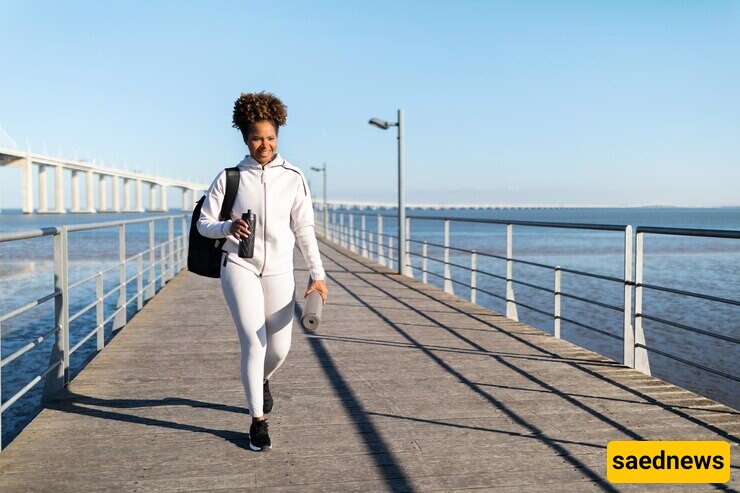SAEDNEWS: You might have heard that walking improves blood circulation and boosts energy levels. However, you may not have realized that walking slowly can actually reduce your lifespan. If you're curious about why this happens, stay with us.

Researchers warn that walking slowly significantly increases the risk of death from heart disease. Studies show that elderly individuals who walk at a slower pace are three times more likely to die from cardiovascular diseases compared to those who walk briskly.

While experts have long known that slow walking is associated with higher hospitalization rates, increased risk of falls, and physical disabilities, recent findings suggest a strong connection between slow walking and a higher risk of death from heart attacks and strokes.
In a study published in the British Medical Journal, researchers analyzed data from a five-year study involving 3,208 men and women aged 65–85. Over this period, 209 participants passed away. The study, conducted by researchers from Pierre and Marie Curie University in France, revealed that individuals with the slowest walking speeds were three times more likely to die than their faster peers.
Walking is an affordable and low-maintenance exercise that offers tremendous physical and mental health benefits. The faster you walk, the greater the benefits. However, older adults or those with injuries should adjust their pace to suit their physical condition and avoid overexertion.
Improved stamina and mental resilience
Weight loss
Strengthened leg muscles
Research shows that brisk walking can reduce the risk of death by 24%, while moderate-paced walking reduces it by 20%.
Additionally, brisk walking lowers the risk of cardiovascular-related death by 24%.
In older adults, brisk walking is even more effective at reducing the risk of cardiovascular diseases. Studies indicate that elderly individuals who walk briskly are 46% less likely to die from heart-related issues.
Fast walking is also safer than running, with a lower risk of injury when done with proper technique. Walking uses muscles like pumps to improve blood circulation, benefiting overall health.
As an aerobic exercise, fast walking is one of the most effective ways to burn fat. It engages multiple muscle groups, including those in the upper body, arms, and legs.
Interestingly, there’s even a sport called “Speed Walking”, which has been part of the Olympic Games since 1956 as a 20 km track and field event for both men and women.
While both running and fast walking have unique advantages, fast walking puts less stress on the body and is generally considered safer.
To maximize benefits and prevent injury, follow these key guidelines for proper walking posture and technique:
Maintain an Upright Posture:
Stand straight and avoid slouching.
Keep your shoulders back and your head up, looking ahead to avoid neck and spine strain.
Maintain the natural curve of your lower back to prevent upper body fatigue.
Use Your Arms Effectively:
Bend your arms at the elbows and keep them close to your body.
Swing your arms in coordination with your steps.
Avoid overextending your arms, as this can reduce your walking speed.
Engage Your Core:
Tighten your abdominal muscles without bending your back or slouching.
Step Efficiently:
At the end of each step, push off with the front of your foot and toes to propel yourself forward powerfully.
This also strengthens your calf and lower leg muscles.

For a comfortable and enjoyable walking experience, the most essential item is a pair of well-fitted walking shoes. While appropriate clothing and socks also enhance comfort, they can be chosen based on personal preference.
Avoid cotton socks, as they trap moisture and increase the risk of blisters.
Flexibility:
Shoes should be flexible but not overly so.
If the arch area bends excessively, the shoe won’t provide proper support.
Heel Design:
Choose shoes with a slightly angled heel for better grip on slopes.
Durability:
Durable shoes absorb impact and reduce the risk of injury.
Purpose-Built:
Opt for walking-specific shoes, not running shoes. Running shoes are designed differently and may disrupt walking posture.
Comfort Over Style:
Try different brands and prioritize comfort and functionality over trends.
Proper Sizing:
Choose shoes that are half a size larger to accommodate slight foot swelling during long walks.
Whether you’re walking for health, fitness, or enjoyment, paying attention to technique, posture, and equipment can significantly enhance your experience.
Fast walking is an accessible, low-risk, and highly effective exercise with numerous benefits for your health and well-being.
We hope you found this guide helpful! Share it with others who might benefit, and for more valuable insights, explore the Saed News Sports World section.
Thank you for joining us on the journey to better health—one step at a time!

